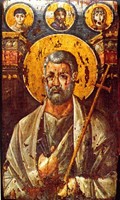Encaustic Painting
Paint Method Using Beeswax Binder: Advantages,
Disadvantages, History.
MAIN A-Z INDEX - A-Z of PAINTING
|
Encaustic Painting |
|
|
Encaustic Painting Method (c.500 BCE - present)Contents • What is Encaustic
Paint? |
 One of many Encaustic Icon paintings found at St Catherine's Monastery, Mount Sinai. (c.550 CE). |
In fine art, the word "encaustic" describes both the paint and painting technique which uses hot beeswax to bind colour pigments and to facilitate their application to a surface. An invention of Greek art, its name derives from the Greek word meaning "burnt in". The paint is applied to the painting surface (usually a wooden panel, or a wall), after which it is reheated to fuse the paint into a uniform enamel-like finish, devoid of all brushmarks. Ancient artists applied the paint using brushes and spatulas to create the image. On completion, they applied a flaming torch to the painting's surface to reheat the wax, causing it to meld permanently with the pigments and with the panel/wall. Nowadays, heat lamps, heat guns or even electric irons are used to create the same effect. These modern tools give the painter more time to work with the material. The most straightforward encaustic recipe involves adding pigments to beeswax, but other types of waxes and resins can also be used. |
|
FORMS OF ARTS PAINTING TERMINOLOGY |
Characteristics: Advantages, Disadvantages Encaustic is as versatile as any painting medium, and has a range of textural and colour advantages that make it an excellent alternative to oil painting in many different situations. Capable of being polished to a high gloss, it can be modelled, sculpted, and combined in mixed-media works with collage and other items of junk art. Most important, it cools almost immediately, with minimum drying time, yet it can always be reworked. And as beeswax is impermeable, it will not deteriorate, or darken or turn yellow, and encaustic paintings need not be protected under glass. Encaustics are also environmentally safer, as they emit no toxic fumes, and do not require the use of solvents. Their sole disadvantage is their need to be kept in a molten state, although modern tools have made this a relatively trivial task. Encaustic painting originated in Classical Antiquity. According to the Roman historian Pliny, writing in the first century CE, it was allegedly invented by Greek artists during the age of Classical Greek Painting (c.480-323 BCE), using techniques borrowed from ship-painters who incorporated wax in order to weatherproof the hulls of their boats. (Pliny even mentions the names of two artists who trained initially as ship painters.) It quickly became one of the main methods of painting in Egyptian, Greek, Roman and Byzantine art, notably Christian Byzantine art. Pliny also recorded that encaustic paint was employed in sculpture and other plastic art, for the colouring of marble and terracotta works, as - when heated - the wax/pigment mixture had a particularly strong adhesive quality.
Encaustic paint was widely used for panel-paintings, in Classical and later Hellenistic Greek painting. Unfortunately, because of the perishable nature of these wooden panels, not a single Greek panel painting of any quality has survived, nor any Roman copy. The finest surviving encaustic paintings are the Greek-style Fayum Mummy Portraits (c.50 BCE - 250 CE) painted by Greek painters in Egypt, which were discovered around the Fayum Basin, to the west of the Nile, south of Cairo, in the vicinity of Hawara, Achmim and Antinoopolis. Following the victories of Alexander the Great (356-323 BCE), a sizeable Greek population had settled in Egypt, where they soon adopted the customs of the native community including the mummification of their dead. Well-off families typically commissioned a portrait of the deceased, which was affixed to the mummy as a memorial. These portraits have become one of the most celebrated finds in post-pyramid Egyptian art. The style of religious art known as icon painting (icons), which was developed in the monasteries of the eastern Byzantine church, also used encaustic wax paint on portable wooden panels. The greatest collection of such artworks is in the monastery of St Catherine in Sinai, founded in the 6th century by the Emperor Justinian. During the Dark Ages in Western Europe (c.400-800), encaustic paint fell into disuse and was replaced by tempera in the 8th/9th century. Tempera was a faster, easier and cheaper process, than its more painstaking and costly rival. However, the encaustic tradition was widely used in medieval painting across the Eastern Orthodox area, including Russia and Constantinople. For more see: Russian Medieval Painting (950-1100) especially Novgorod School of Icon Art (1100-1500). The greatest Russian icon painters, all of whom used encaustic as well as tempera methods, include: Theophanes the Greek (c.1340-1410), founder of the Novgorod and Moscow schools; Andrei Rublev (c.1360-1430), Russia's most famous icon artist; and Dionysius (c.1440-1502), the last great Old Masters of Medieval Russian art. Encaustic Painting in the Modern Era European artists like Vincent Van Gogh (1853-90) and Julius Schnorr von Carolsfeld (1794-1872) added wax to oil paint to facilitate the separation of clear areas of colour. In the twentieth century, the technique of encaustic painting was revived in the Mexican murals created by Diego Rivera (1886-1957), as well as the American artist Jasper Johns (b.1930), a founding father of Pop Art, who used it in a number of pictures of the American Flag.
|
|
• For more about encaustic painting techniques, see: Homepage. ENCYCLOPEDIA OF FINE ART |